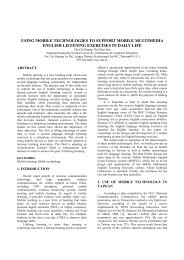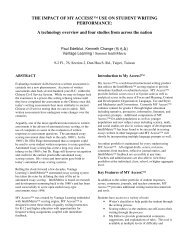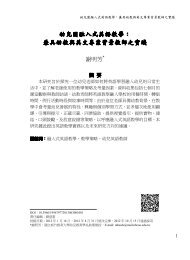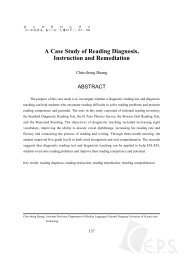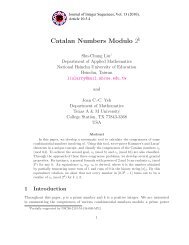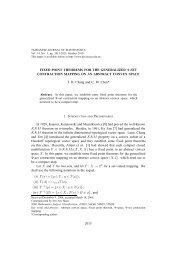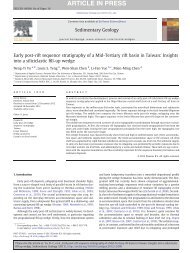Estimation of parameters of the Gompertz distribution using the least ...
Estimation of parameters of the Gompertz distribution using the least ...
Estimation of parameters of the Gompertz distribution using the least ...
You also want an ePaper? Increase the reach of your titles
YUMPU automatically turns print PDFs into web optimized ePapers that Google loves.
138 J.-W. Wu et al. / Appl. Math. Comput. 158 (2004) 133–147<br />
Garg et al. [7] derived <strong>the</strong> ML estimates <strong>of</strong> c and k from<br />
^c ¼<br />
^k ¼<br />
(<br />
(<br />
n Xn<br />
i¼1<br />
^c Xn<br />
i¼1<br />
<br />
e^cx ðiÞ<br />
)(<br />
1<br />
x ðiÞ<br />
^c<br />
) (<br />
1<br />
X n<br />
i¼1<br />
<br />
X n<br />
i¼1<br />
e^cx ðiÞ<br />
x ðiÞ<br />
X n<br />
i¼1<br />
<br />
1<br />
<br />
e^cx ðiÞ<br />
X n<br />
i¼1<br />
<br />
1<br />
n Xn<br />
i¼1<br />
x ðiÞ e^cx ðiÞ) 1<br />
;<br />
ð5Þ<br />
x ðiÞ e^cx ðiÞ) 1<br />
: ð6Þ<br />
Thus it is only necessary to obtain a solution <strong>of</strong> Eq. (5) which will be <strong>the</strong> MLE<br />
<strong>of</strong> c. An iterative solution to Eq. (5) can be achieved by NewtonÕs method; <strong>the</strong><br />
initial estimate ^c 0 may be selected as <strong>the</strong> LSE <strong>of</strong> c. The MLE ^k can <strong>the</strong>n be<br />
obtained from Eq. (6).<br />
2.2. Least squares estimates under <strong>the</strong> first failured-censored sampling plan<br />
The p.d.f. <strong>of</strong> <strong>the</strong> first-order statistic X ð1Þ is<br />
k<br />
<br />
<br />
f ðx; c; k Þ¼k e cx exp<br />
c ðecx 1Þ ; ð7Þ<br />
where k ¼ nk. The corresponding c.d.f. is<br />
k<br />
<br />
<br />
F ðxÞ ¼1 exp<br />
c ðecx 1Þ : ð8Þ<br />
Suppose X ð1Þ1 ; X ð1Þ2 ; ...; X ð1Þm denote <strong>the</strong> set <strong>of</strong> first-order statistics <strong>of</strong> m<br />
samples <strong>of</strong> size n from (1) and let Y ð1Þ < Y ð2Þ < < Y ðmÞ be <strong>the</strong> corresponding<br />
order statistics. Clearly, X ð1Þ1 ; X ð1Þ2 ; ...; X ð1Þm can also be considered as a random<br />
sample from (7). Then F ðxÞ in (8) satisfies<br />
<br />
lnf lnð1 F ðxÞÞg ¼ ln n þ ln k þ ln ecx 1<br />
: ð9Þ<br />
c<br />
For observed ordered observations y ð1Þ < y ð2Þ < < y ðmÞ , (9) can be rewritten<br />
as<br />
<br />
lnf lnð1 F ðy ðiÞ ÞÞg ¼ ln n þ ln k þ ln ecy ðiÞ<br />
1<br />
; i ¼ 1; ...; m: ð10Þ<br />
c<br />
Proceeding as in Section 2.1, we can obtain <strong>the</strong> unweighted and weighted<br />
<strong>least</strong> squares estimates <strong>of</strong> c and k. Likewise, we can also obtain <strong>the</strong> ML estimates<br />
<strong>of</strong> c and k under <strong>the</strong> first failured-censored sampling plan.





